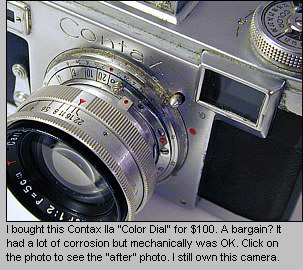I was going to title this, "Buying a used Contax," but then I realized that unless you chance upon a 50-year-old unopened box, you're assured of buying a used camera.
There's nothing wrong with a used camera. That's the first thing to realize, but if you're a fan of classic cameras, then you've either accepted that or you already have a collection.
Here are some thoughts, based on my own experiences. The prices I quote are through eBay auctions. Expect to pay from 75% to 150% more when buying from a camera store.
.jpg) Zeiss Ikon turret viewfinder for Contax IIa/IIIa with case. |
The Contax II is the bargain of the group, generally selling for $175 to $250, and I can't think of any reason you should pay more than that, unless the camera is in pristine condition or it's one of the (truly) rare postwar Jena models. East Germany produced a small number of Contax II cameras in Jena before the Soviets carted away the equipment and personnel to Russia to make the Kiev.
The Contax IIa sells from $300 to $450, depending on condition and your luck. You might get one cheaper, and if you find one, buy it.
 •
What to look for: Unless someone
has performed service on the camera, you should expect that it will need to be
cleaned, lubricated and adjusted at the minimum or require a more thorough
overhaul. It largely depends on how the camera was stored. Attics are better,
because they tend to be drier. The truth is that most cameras have been
sitting in a box in a damp garage or basement for several decades.
•
What to look for: Unless someone
has performed service on the camera, you should expect that it will need to be
cleaned, lubricated and adjusted at the minimum or require a more thorough
overhaul. It largely depends on how the camera was stored. Attics are better,
because they tend to be drier. The truth is that most cameras have been
sitting in a box in a damp garage or basement for several decades.
Check that the shutter operates on all speeds; it's not unusual for 1250 to not work, but it might return through use. Remove the back, hold the camera up to a light and check each speed. On slow speeds, you should hear the steady whir of the slow-speed mechanism. Same goes for the self-timer. A stuttering sound indicates a need for service. Look for corrosion. Check the rangefinder to see if the yellow rangefinder patch is visible. Can you focus the camera? Most problems can be corrected, except for rangefinder separation -- you'll need to replace the prisms.
You can do the work yourself -- you'll be in for a real adventure.
• Buying online: The real disadvantage in buying online is not being able to touch the camera. You can either take your best shot and buy blind, which I've done or you can ask thorough questions. Some buyers genuinely might not know about the camera. Others might be able to provide answers. And it's very possible that some simply won't reply. But ask questions. If you don't like the answers, don't buy the camera. Resist the urge to buy because, "you'll never see another like this one." You will.
• Lenses: The price for the standard Sonnar is all over the map. But always check for scratches or fungus on the lens surface or oil on the aperture blades or scratches. For wide-angle and telephoto lenses, make sure the lens focuses smoothly, especially with the East German lenses.
The excellent 50mm f/1.5 Sonnar shouldn't cost you more than $150 for a coated lens and a bit less for the uncoated lens. Figure on $75 to $100 or so for the other Sonnars.
Postwar Biogons are very expensive: $400 for a 35mm, and more than $600 for a 21mm. The 85mm f/2.0 Sonnar will cost at least $350. A real bargain is the sharp 135mm f/4.0 Sonnar, often selling for less than $150.
.jpg)